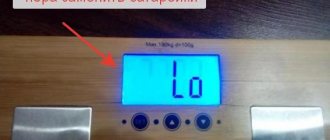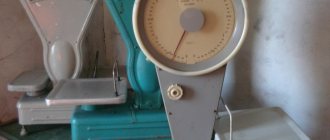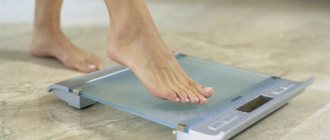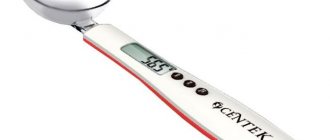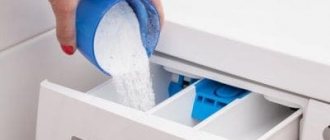Types of scales
Modern household scales come in two types: mechanical and electronic. Mechanical ones have an analog dial, often small, with a division value of 1 kg. Accordingly, the accuracy they provide when weighing is +/- 0.5 kg. For most people who just want to know approximately their weight, this option is suitable. However, for athletes, as well as in medicine, such accuracy is not enough. Electronic scales provide results with an accuracy of up to 100 grams (there are models that show every 10 g). The value is displayed on the screen. Advanced models of scales have additional functions, for example, a built-in calculator/body analyzer, which allows you to calculate the proportions of the body by component composition directly during weighing.
Electronic scales with body composition analyzer
Structurally, electronic scales consist of some kind of sensor and a system for displaying the result. Simple inexpensive copies have a spring sensor, the data from which is digitized and shown on the display. Newer models have a strain converter. Such devices have maximum accuracy, as they are completely electronic. Most often, they have built-in intelligent systems that allow one to determine additional information about the state of the body.
Load cells
Let's discard the well-known information about mechanical scales. The platform of electronic brothers is motionless. The measurements are taken by the legs. Hidden under each one are durable carbide frames that deform when a person operates the scales.
The changes cannot be detected with the eye; the difference is so small that it cannot be determined by the building level. On each frame there is a tiny plate less than 2 centimeters in diameter. The designated one is the sensor unit of electronic scales. The part serves as the basis for floor and other models. The products differ in the method of mounting the strain gauge sensor.
The sensitive plate is firmly imprinted into the frame and filled with compound (glue). The sensor is powered by three wires that measure the resistance of the bridge arms. A person wants to know the mass of the body, tramples the platform, the four corner frames bend, dividing the excess mass in proportion to the lengths. The final readings are obtained by summing the numbers. The process is controlled by the scale's printed circuit board: three wires run into each corner.
The measuring bridge is formed by a square, each side contains a resistor. One diagonal receives power, the other is a source of readings. Official sources are silent about the composition of the circuit diagrams. Let's assume that two resistors are in the frame, and the others are in the printed circuit board of the scales. Three wires guarantee a reliable electrical connection. A detailed explanation is given so that the reader understands that it is difficult to damage the scale sensors. Ordinary glands, destroyed exclusively mechanically. Resists moisture (but not the PCB).
Why electronic scales can “lie”
It happens that several weighings performed in a row have different results. This problem occurs frequently and frustrates users. The reasons for this lie in improper operation of the equipment and even in small nuances in the weighing process.
The main reasons are discussed below.
- The scale must stand on a perfectly level floor. Any unevenness makes the sensor work incorrectly. In this situation, you need to place the scales in another, more suitable place.
- You also need to step on the scales correctly: straight, without pressing or skewing on one side. The feet should be placed parallel to each other, at the same level. It is advisable to stand on the platform at each weigh-in with your feet equally positioned and your weight evenly distributed.
Correct placement of feet on scales
- The legs should be on the platform with the entire surface of the foot. The body is at right angles to the horizontal. Point pressure with your heels and/or toes can significantly distort the result.
- Electronic scales work using sensitive sensors. Negative environmental influences, such as severe changes in room temperature, can affect the accuracy of measurements.
- It has been noticed that near heating devices, scales can also show a result that differs from the real one.
- It is important to properly care for electronic scales. In particular, washing them with aggressive detergents is strictly prohibited. Chemicals can negatively affect sensors and electronics that convert measurement information. Glass scales are best suited for everyday use: they are quite accurate and easy to care for.
Glass scales are easier to care for
Any electronics requires careful use. Libra is no exception. To avoid problems and make measurements as accurate as possible, you should study the user manual.
Cleaning Components
There are times when scales malfunction due to accumulated dirt and dust, so they need to be cleaned periodically. Cleaning simultaneously acts as an additional preventative measure for the equipment. The procedure involves completely disassembling the unit and removing accumulated dirt using a brush. The work must be carried out very carefully so as not to damage the cable or wire.
Dust deposited near the strain gauges can greatly distort weight information. Using a rag when cleaning the unit will ensure complete safety for the board and other equipment elements.
Possible breakdowns of electronic scales
If the floor scales are used correctly, but the result is different each time, they are most likely broken. You can carry out a preliminary diagnosis of the malfunction using the following symptoms.
- The scales do not turn on and no information is displayed on the screen at all. This may indicate that the device is not powered, that is, its power supply (battery) is dead. To solve the problem, it is enough to replace the batteries with new ones. In advanced models, a dead battery produces a specific error code.
Replacing the battery in the scales
- Loss of contact between the scale cable on one side. This element connects the electronic unit and the visualization unit (display). If the cable has moved away from one of the elements, the scale may show strange symbols or nothing at all. You can solve the problem by removing the protective cover and inserting/pressing the board more tightly to the display.
- It happens that the scales show an unexpected result. For example, an adult weighs 15 kg, or weighs 30 kg more than yesterday, without changing in appearance. Most often, it is a matter of wear of the contact elements. In this case, the relay must be replaced.
- The appearance of gaps not provided for by the design leads to damage to the scales. This happens if the device sits on the floor all the time and is not put away in its packaging or cleaned regularly. In this case, the scale must be disassembled and all components carefully cleaned with a soft brush.
- Another reason why scales can “lie” is incorrect calibration of the device. Some models do it automatically when installed on the surface and turned on, others must be configured manually. How to do this can be found in the user manual for a specific device.
Scale calibration
The load cell is broken
The scale model is characterized by the maximum weight of the load being installed (human body, weights), the limit cannot be exceeded - you will bend the power elements of the frame. It is enough to straighten the iron, restoring performance, as mentioned above.
Let's say that the bathroom scales are visually in perfect order. A tester will help identify the problem. Each sensor is carefully unsoldered from the board, and the resistance between the three wires is measured. The results should be the same at the four corners of the bathroom scale. If a gap is observed, the problem has been found.
It is recommended to carefully pick apart the glue (compound) covering the sensitive plate. Mechanical damage to the part will instantly cause complete failure of the unit. Inside you will find a copper-colored plate: three wires are soldered here. Rarely, but it happens, one is torn off. Restore the electrical connection and the bathroom scale will be operational again.
If you find a dead sensor, find (buy) a similar one. Repairing kitchen scales is not difficult: you will find a large number of strain gauge models on sale. Even if a structural element is purchased, a calibration problem arises. Special equipment is required; it is practically difficult to select a third-party sensor that demonstrates similar parameters. Bathroom scales can lie a lot.
Calibration, purpose
The load cell is unique; there is no copy in the Universe, even if the two products being compared left the assembly line as an inseparable pair. When making measurements, bridge connections will always produce an error; calibration is designed to eliminate this negative phenomenon. Let's note the trick. Since the final weight is calculated by adding up, if the only sensor on the bathroom scale is faulty, you can eliminate the broken leg from the process. We offer two options:
- simply release the faulty leg from the load;
- or simulate the desired no-load values with ohmic resistors.
The first one works if the sensor is lying and is incorrectly calibrated. The second (see list) is done with ease, because the resistances have been previously measured. All that remains is to connect according to the diagram and carefully place it inside the case. The faulty sensor is disconnected, continuing to play the role of an ordinary leg. The adders will count the weight of the leg as zero.
Some models allow manual calibration, which is typical for professional models and is rarely found in everyday life. Having unearthed a similar broken specimen, remove the necessary parts.
It is important to understand: repairing floor scales with your own hands requires ordinary ingenuity. A smart device is a bunch of resistors plus a microscopic electronic board.
Selection Guide
In order to avoid problems with purchased scales in the future, you should listen to the opinions of experts who recommend paying attention to the following points when purchasing.
- If you come across a model with a choice of units of measurement, make sure that kilograms are present in the table.
- For use in the bathroom, you should buy a model with moisture protection.
- For comfortable use, choose floor scales with a rough surface rather than a smooth one.
- When choosing a material, it is better to trust metal models rather than plastic ones.
- Don't skimp on your purchase. Cheap models don't last long, the weight they display isn't always accurate, and you'll end up overpaying for repairs or buying a new scale.
- Be sure to check the measurement accuracy before purchasing.
- When working with scales on a carpet, the calculation error can be up to 10%.
- Do not use models that are not designed for your weight.
- Magnetic radiation from instruments located in the room can affect the quality of weighing, so make sure that the scales are located away from radio equipment.
- When purchasing electronic models, choose a model with 4 sensors. This information is not always indicated on the price tag, so you will have to look at the device’s passport.
- The more built-in functions a device has, the greater the error in their calculations. Try to choose simple and reliable models.
Do not forget that electronic scales operate on batteries, which need to be changed at least once every 6 months.
Rules for care and use
For correct operation, it is important not only to choose and use the device correctly, but also to properly care for it. By following a few tips for maintaining your instrument, you will achieve longer life and more accurate weighing:
- Electronic scales are known to be extremely sensitive. Therefore, you should avoid sudden changes in temperature, large amounts of moisture, sudden lowering or shaking, exposure to dirt and direct sunlight.
- Do not place the scale near heating devices.
- It is not recommended to use chemicals to clean the device.
- Avoid contact of various liquids with the surface of the measuring unit.
